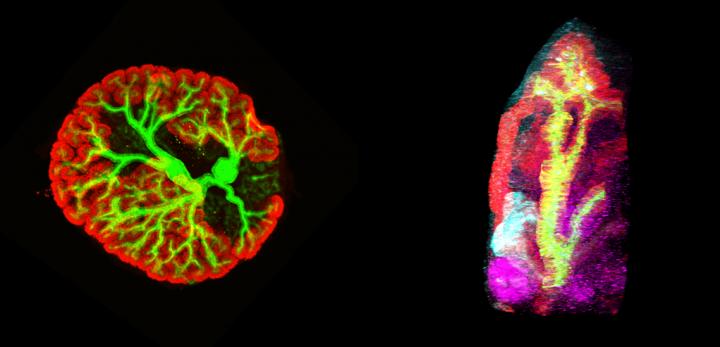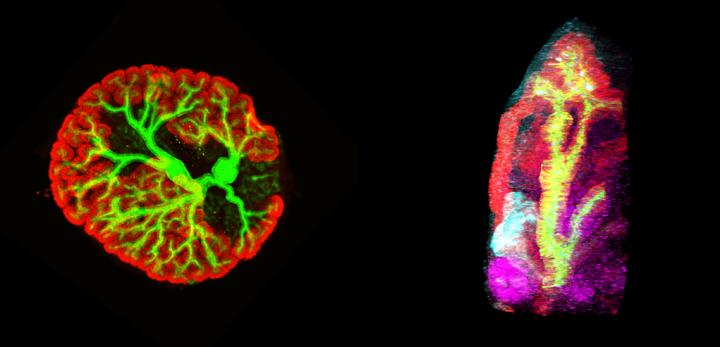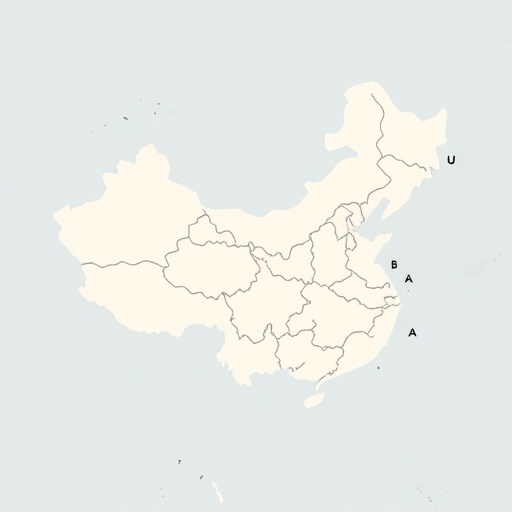
Credit: Dr. Atsuhiro Taguchi & Professor Ryuichi Nishinakamura
In the embryonic kidney, three types of precursor cells, nephron progenitor cells, ureteric buds, and interstitial progenitor cells, interact to form three-dimensional structures of the kidney. Methods to induce nephron structures via nephron progenitor cells from mouse pluripotent stem cells (PSCs) have already been established. However, since other progenitor cells were not included, the "higher-order" structures of the kidney (the state in which differentiated nephron structures are organically connected to each other by branching collecting ducts) were not reproduced. Now, a Japanese research group has developed a method of using PSCs to induce production of ureteric buds, the progenitors of branched collecting ducts, and has succeeded in reproducing the higher-order structure of the kidney.
Increasing numbers of patients suffer from chronic kidney disease, and more than 2 million people worldwide are affected by end stage renal disease. Patients undergoing hemodialysis have a decreased QOL as they need several hours of treatment every week for the rest of their lives. Unfortunately, opportunities for kidney transplantation are limited and the 2006 discovery of iPS cells by Professor Yamanaka et al. of Kyoto University, Japan has elevated the expectation for regenerative medicine to "build" fully functioning organs. However, the process of reproducing a whole organ structure continues to be a common and challenging theme for any organ regeneration study. The regenerative medicine researchers from Kumamoto University's Institute of Molecular Embryology and Genetics (IMEG) in Japan are working toward the goal of producing a fully functional kidney. To do so, it is important to reconstruct higher-order kidney structures from PSCs.
Previous studies revealed that the interaction of three types of progenitor cells are essential for embryonic kidney organogenesis: the nephron progenitor cells that form the nephrons, the ureteric buds that are the base for collecting ducts, and the interstitial progenitor cells that create the tissues that fill the gap between structures. Ureteric buds are particularly important because they play a central role in kidney higher-order structure development.
At the end of 2013, the Kumamoto University research group pioneered an induction method for nephron progenitor cells from mouse embryonic stem cells (ESCs) and human iPS cells, and were successful in creating three-dimensional kidney tissue that included nephron structures. Since then, several methods for creating nephrons have been reported from various laboratories around the world. However, no study has reproduced the branching structure of the collecting ducts that interconnect nephrons. These interconnections are essential because urine produced by the nephrons must pass through the collecting ducts and into the ureter on its way to the bladder for excretion. Thus, the researchers investigated a method to induce ureteric buds from PSCs, and aimed to reproduce kidney structures by combining PSC-derived nephron and embryonic stromal progenitor cells.
They first discovered that mouse Wolffian ducts (WDs), precursors of ureteric buds, gradually matured and gained branching capacity between embryogenesis day (E) 8.75 and E11.5. They were then able to culture WD cells in vitro and determined the growth factors necessary to produce mature ureteric buds. Finally, they developed a protocol to induce E11.5 ureteric bud-like cells from mouse ESCs via E8.75 WD-like cells. It was revealed here that nephron progenitor cells and ureteric buds require individually optimized conditions for successful induction.
Functionality of mouse ESC-derived ureteric buds was further verified by co-culturing a single bud with embryonic kidney precursors, or with a mixture of ESC-derived nephron progenitors and embryonic stromal progenitors. In the reconstructed kidney organoid, researchers observed the formation of branching ureteric epithelium, differentiated nephrons, and nephron progenitors on the surface of the ureteric bud tips, thereby confirming the functionality of induced ureteric buds and the reconstruction of higher-order kidney structures.
With a slight modification of the protocol, the researchers were able to induce ureteric buds from human iPSCs, and confirmed their branching capacity when cultured with growth factors. When they performed the same experiment on a human iPSC line depleted of PAX2, a gene known to be essential for ureteric bud formation in mice and for kidney development in humans, ureteric buds were not induced and branching was not observed. Thus, it is feasible to use ureteric buds derived from iPS cells to study kidney abnormalities caused by genetic mutation.
"Our results show the possibility of reconstructing, to some extent, higher-order organ structures from PSCs. They key is to induce and combine different types of progenitor cells according to individual developmental origins and maturation processes," said Assistant Professor Atsuhiro Taguchi of Kumamoto University*, who lead the research. "This work provides a fundamental strategy for kidney organ regeneration, and opens the door to elucidate mechanisms of organogenesis."
"This study shows how to artificially reproduce the shape of complex organs such as the kidney. However, to make complete organs from PSCs, it is essential to develop a method to induce interstitial progenitor cells," added Professor Ryuichi Nishinakamura, coauthor and head of the research laboratory where this discovery was made. "For the kidneys to function and grow properly, incorporation of vascular tissues is indispensable. There are still many problems remaining in developing kidney tissues for transplantation, but this study should further the progress of kidney regeneration research. For example, reproduction and examination of congenital malformations in collecting duct tissue should see a great improvement simply because we are now able to create collecting duct tissue as needed–a task which has not been available to regenerative science till now."
###
This research was posted online in the journal "Cell Stem Cell" on 9 November 2017.
*Dr. Taguchi is now affiliated with the Max Planck Institute for Molecular Genetics in Germany.
[Source]
Taguchi, A., & Nishinakamura, R. (2017). Higher-Order Kidney Organogenesis from Pluripotent Stem Cells. Cell Stem Cell, 21(6), 730-746.e6. doi:10.1016/j.stem.2017.10.011
Media Contact
J. Sanderson, N. Fukuda
[email protected]
http://ewww.kumamoto-u.ac.jp/en/news/
Original Source
http://www.cell.com/cell-stem-cell/abstract/S1934-5909(17)30428-9 http://dx.doi.org/10.1016/j.stem.2017.10.011





